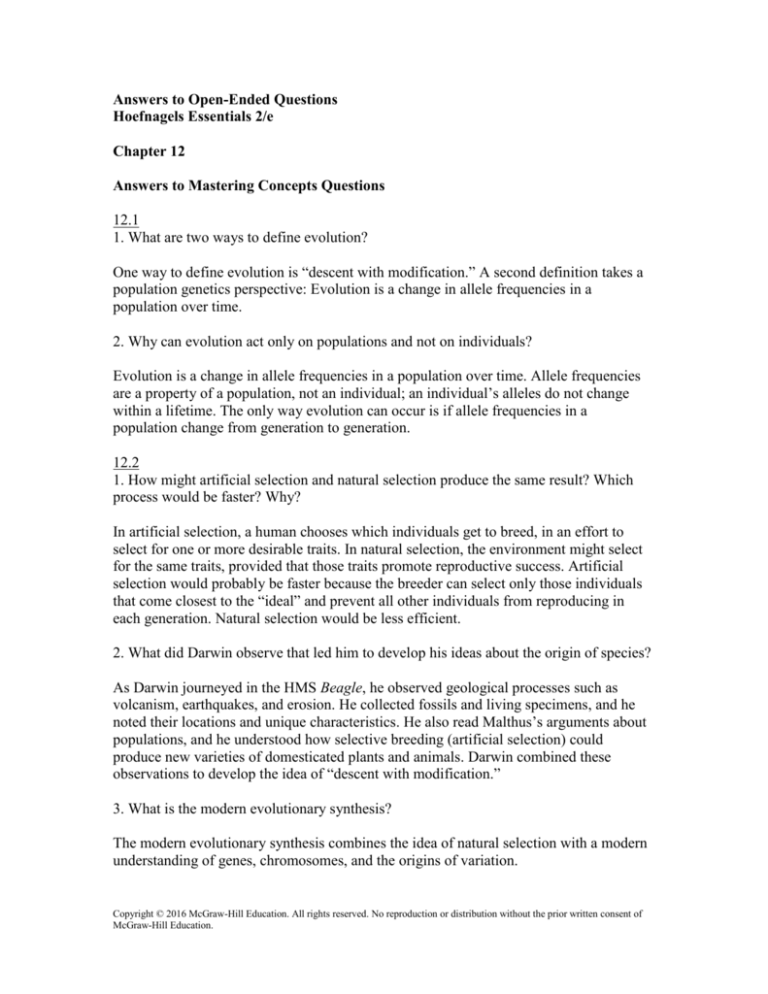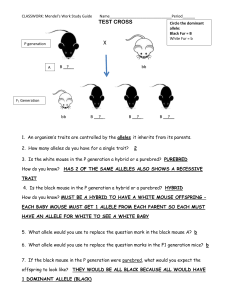
Answers to Open-Ended Questions
Hoefnagels Essentials 2/e
Chapter 12
Answers to Mastering Concepts Questions
12.1
1. What are two ways to define evolution?
One way to define evolution is “descent with modification.” A second definition takes a
population genetics perspective: Evolution is a change in allele frequencies in a
population over time.
2. Why can evolution act only on populations and not on individuals?
Evolution is a change in allele frequencies in a population over time. Allele frequencies
are a property of a population, not an individual; an individual’s alleles do not change
within a lifetime. The only way evolution can occur is if allele frequencies in a
population change from generation to generation.
12.2
1. How might artificial selection and natural selection produce the same result? Which
process would be faster? Why?
In artificial selection, a human chooses which individuals get to breed, in an effort to
select for one or more desirable traits. In natural selection, the environment might select
for the same traits, provided that those traits promote reproductive success. Artificial
selection would probably be faster because the breeder can select only those individuals
that come closest to the “ideal” and prevent all other individuals from reproducing in
each generation. Natural selection would be less efficient.
2. What did Darwin observe that led him to develop his ideas about the origin of species?
As Darwin journeyed in the HMS Beagle, he observed geological processes such as
volcanism, earthquakes, and erosion. He collected fossils and living specimens, and he
noted their locations and unique characteristics. He also read Malthus’s arguments about
populations, and he understood how selective breeding (artificial selection) could
produce new varieties of domesticated plants and animals. Darwin combined these
observations to develop the idea of “descent with modification.”
3. What is the modern evolutionary synthesis?
The modern evolutionary synthesis combines the idea of natural selection with a modern
understanding of genes, chromosomes, and the origins of variation.
Copyright © 2016 McGraw-Hill Education. All rights reserved. No reproduction or distribution without the prior written consent of
McGraw-Hill Education.
12.3
1. What is the role of genetic variation in natural selection?
Genetic variation is the raw material that natural selection acts on. Genetic variation
creates variations in phenotypes, some of which are more likely than others to lead to
reproductive success in the current environment.
2. How can natural selection favor different phenotypes at different times?
Natural selection can favor different phenotypes at different times because environments
and selective forces are always shifting.
3. What happens to a population if conditions change and no individuals have the allele
combinations required to survive and produce offspring?
The population goes extinct.
4. What is “fitness” in the context of evolution?
Fitness is an organism’s contribution to the gene pool in the next generation. The more
offspring an individual produces, the more fit the individual is.
12.4
1. What five conditions are required for Hardy-Weinberg equilibrium?
The five conditions required for Hardy-Weinberg equilibrium are: (1) natural selection
does not occur; (2) mutations do not occur; (3) the population is large enough to
eliminate random changes in allele frequencies (genetic drift); (4) mating is completely
random; (5) no individuals migrate into our out of the population.
2. Why doesn’t Hardy-Weinberg equilibrium occur in real populations?
In real populations, at least one of the requirements for Hardy-Weinberg equilibrium is
always violated. For example, both mutations and natural selection are inevitable.
12.5
1. Distinguish among directional, disruptive, and stabilizing selection.
Directional selection selects against phenotypes at one end of the variation spectrum in a
population. In disruptive selection, extreme phenotypes are more fit than the
intermediate phenotype; the frequency of the intermediate phenotype therefore decreases
in the population. In stabilizing selection, both extreme variations of phenotype are
selected against; intermediate phenotypes are most common.
2. How can natural selection maintain harmful alleles in a population?
Copyright © 2016 McGraw-Hill Education. All rights reserved. No reproduction or distribution without the prior written consent of
McGraw-Hill Education.
If a harmful allele is recessive, and if heterozygotes carrying the recessive allele have a
reproductive advantage over homozygous individuals, then natural selection may
maintain a balanced polymorphism. In that case, both the dominant and recessive allele
are maintained indefinitely, even if individuals who are homozygous recessive for the
harmful allele are at a severe disadvantage.
12.6
1. How does sexual selection promote traits that decrease survival?
Sexual selection selects for extreme phenotypes in one sex, and those extreme variations
often place the individual at a disadvantage for survival (e.g., a peacock’s longer tail will
make him more visible to predators and slower in escaping). However, since these traits
increase fitness by increasing mating success, they are maintained in the population.
2. Describe two ways in which competition for access to mates can lead to sexual
selection.
Members of one sex may compete for access to members of the other sex (e.g., male
rams fight for access to females) or members of one sex may be choosy about mates (e.g.,
females choose the male weaver bird that builds the best nest).
12.7
1. How do mutations affect an organism’s phenotype?
Mutations introduce new alleles, which may or may not alter the phenotype of an
organism. The new phenotype may reduce reproductive success, have no effect, or
promote reproductive success.
2. Under what conditions does a mutation in one organism pass to subsequent
generations?
In a sexually reproducing organism, only mutations in the gamete-producing cells (eggs
or sperm) can pass to the next generation. Asexual organisms pass all mutations to the
next generation.
3. How does sampling error cause genetic drift?
Sampling error occurs when a selected sample does not match the larger original pool.
For example, only a small subset of the alleles in a larger population may make it to the
next generation. Such sampling errors change the allele frequencies of a population, not
as a result of natural selection, but as a result of pure chance (genetic drift).
4. What is the difference between the founder effect and a population bottleneck?
Copyright © 2016 McGraw-Hill Education. All rights reserved. No reproduction or distribution without the prior written consent of
McGraw-Hill Education.
In the founder effect, a new population is started by a small group of individuals that
colonize a new area. In a population bottleneck, a large and genetically variable
population experiences a massive die-off, and only a few individuals survive to continue
the population. In either case, a small population contains a random subset of the alleles
present in the original, larger population.
5. How do nonrandom mating and migration result in evolutionary change?
Nonrandom mating means that not all individuals have an equal chance of reproducing;
as a result, some allele combinations will become more frequent than others in
subsequent generations. Migration causes alleles to enter or leave the population, altering
the allele frequencies.
Write It Out
1. List and describe five mechanisms of evolution.
(1) Natural selection: differential survival and reproduction of individuals within a
population. (2) Mutation: random changes in an allele, sometimes providing a new
phenotype. (3) Genetic drift: random loss of alleles in a population. (4) Nonrandom
mating: some individuals have more opportunities to mate and therefore leave more
offspring. (5) Migration: alleles move from one population to another.
2. How did the work of other scientists influence Charles Darwin’s thinking?
The theories and ideas of Georges-Louis Buffon and Jean Baptiste de Lamarck led many
in the scientific community to accept that species can change over time. Charles Lyell
said that natural processes occur slowly; Lyell also suggested that the Earth was much
older than 6000 years, allowing plenty of time for evolution by means of natural selection
to occur. Thomas Malthus illustrated that populations produce many offspring and
compete for resources. Darwin extended Malthus’ theory, suggesting that those
individuals that are able to obtain resources best would be most likely to survive and
reproduce. Alfred Russel Wallace had a similar theory, which prompted Darwin to realize
his idea was worthy of publication.
3. Explain how understanding evolution is important to medicine, agriculture, and
maintaining the diversity of organisms on Earth.
Many answers are correct; here are some possibilities. In medicine, evolution is important
to understanding the origin of human disease, to predicting the future of disease, and to
promoting the wise use of drugs to prevent and treat disease. In agriculture, evolution is
important to developing new crop varieties and to understanding the risk of planting just
one type of crop over wide areas. In biodiversity, evolution is important to understanding
which areas should be preserved because they are likely to house the richest variety of
species.
Copyright © 2016 McGraw-Hill Education. All rights reserved. No reproduction or distribution without the prior written consent of
McGraw-Hill Education.
4. Staphlococcus aureus is a type of bacterium that can often resist antibiotic treatment.
Explain how a population exposed to antibiotics might become more resistant to
antibiotics.
If any member of a population of S. aureus bacteria is resistant to antibiotics, then that
individual will survive antibiotic treatment. It will pass the resistance allele to its
offspring, which will also be resistant to antibiotics. Meanwhile, bacteria that are not
resistant to antibiotics die. Over time, the population shifts from mostly susceptible to
antibiotics to mostly resistant.
5. Jellyfish Lake, located on the Pacific island of Palau, is home to millions of jellyfish.
Many years ago, sea levels dropped and the jellyfish were trapped in the basin. The lake
houses no predators, and the jellyfish’s sting has weakened. Jellyfish Lake is now a
popular tourist attraction where snorkelers can swim among the jellyfish. Explain how
Jellyfish Lake is evidence for evolution.
Sometime in their evolutionary past, a random mutation (or series of mutations) occurred
that weakened the sting of these jellyfish. Because they live in a habitat with no
predators, jellyfish with a weak sting were able to survive as well as those with a strong
sting. Over time, the weak sting alleles spread through the population, most likely
because producing a weaker sting saves energy for other tasks, such as reproduction.
6. Influenza and smallpox are diseases caused by different types of viruses. Scientists
must produce a new influenza vaccine each year, whereas the smallpox vaccine
eradicated the disease. Explain these results from an evolutionary perspective.
Influenza viruses evolve rapidly; the same vaccine that prevents the flu in one year is
therefore likely to be ineffective in the next. The smallpox virus evolves slowly, so
researchers had multiple decades to vaccinate much of the human population. Once
enough of the population was immune to smallpox, the disease could no longer spread,
and it was eradicated.
7. Explain how harmful recessive alleles can persist in populations, even though they
prevent homozygous individuals from reproducing.
Harmful recessive alleles can be maintained in heterozygous offspring, especially if
heterozygotes have a reproductive edge over homozygous dominant individuals.
8. Fraggles are mythical, mouselike creatures that live underground beneath a large
vegetable garden. Of the 100 Fraggles in this population, 84 have green fur, and 16 have
gray fur. A dominant allele F confers green fur, and a recessive allele f confers gray fur.
Assuming Hardy–Weinberg equilibrium is operating, answer the following questions. (a)
What is the frequency of the gray allele f ? (b) What is the frequency of the green allele
F? (c) How many Fraggles are heterozygotes (Ff)? (d) How many Fraggles are
homozygous recessive (ff)? (e) How many Fraggles are homozygous dominant (FF)?
Copyright © 2016 McGraw-Hill Education. All rights reserved. No reproduction or distribution without the prior written consent of
McGraw-Hill Education.
(a) The frequency of the gray allele is 0.4. (b) The frequency of the green allele is 0.6.
(c) The number of heterozygotes is 48. (d) The number of homozygous recessive
individuals is 16. (e) The number of homozygous dominant individuals is 36.
9. One spring, a dust storm blankets the usually green garden of the Fraggles in gray. The
green Fraggles therefore become visible to the Gorgs, who tend the gardens and try to kill
the Fraggles to protect their crops. The gray Fraggles, however, blend easily into the
dusty background. How might this event affect microevolution in the Fraggles? What
mode of natural selection does this represent?
Fraggles that are homozygous recessive (gray) have a better chance of survival and will
therefore have greater reproductive success. Their numbers will increase in future
generations. This represents directional selection.
10. Describe the competing selective forces acting on peacock tails. Together, do these
selective forces produce disruptive, directional, or stabilizing selection?
Natural selection constrains the length of the peacock’s tail; if it is too long and heavy,
the tail will be unwieldy, and the bird will be unable to walk or fly. On the other hand,
females prefer males with a long, extravagant tail. These competing forces eliminate
birds with extreme phenotypes and select for the intermediate phenotype, illustrating
stabilizing selection.
11. Many American farmers routinely use an herbicide called glyphosate to keep their
fields weed-free. They are now reporting the emergence and spread of glyphosateresistant species of “superweeds.” Use natural selection to explain this situation. What
might farmers do to minimize the problem?
The herbicide kills the individuals that do not have the resistance allele(s), leaving only
the resistant individuals to reproduce. If farmers reduced the frequency and amount of
herbicide used, then some susceptible individuals would reproduce as well, mixing their
alleles with the resistant individuals to produce the next generation. Farmers could also
alternate types of herbicide, increasing the chance of killing individuals that are resistant
to only one type.
12. The giraffe in the chapter-opening photo has a long neck. Some researchers suggest
that the elongated neck results from competition for foliage with other types of animals;
others say it is the product of sexual selection. How might each mechanism explain how a
long-necked species evolved from an ancestral population with short necks? How does
each explanation compare to how Lamarck might have explained it?
A giraffe with a long neck would have an advantage if low-lying food were scarce,
because its neck would allow it to outcompete giraffes with shorter necks. Over multiple
generations, long-necked giraffes would become more common in the population. Sexual
selection might also explain giraffe necks. For example, long necks may be adaptive in
battles between males. If long-necked males had the greatest access to females, then long
Copyright © 2016 McGraw-Hill Education. All rights reserved. No reproduction or distribution without the prior written consent of
McGraw-Hill Education.
necks would become more common in the population over multiple generations. In both
cases, evolution occurs in populations over multiple generations, not in individuals. On
the other hand, Lamarck would have said that individual giraffes stretched their necks to
reach the leaves high in the trees. Their offspring would also have long necks.
Pull It Together
1. Describe a situation in which each of the five mechanisms of evolution shown in the
concept map would occur.
Natural selection would occur whenever some individuals have adaptations that reduce
their chance of reproducing; one example would be brightly colored prey animals that
stand out against their background. Mutations occur at random whenever DNA replicates,
creating new alleles. Genetic drift eliminateds some alleles by chance, such as when
humans hunted American bison so quickly that the bison gene pool was greatly
diminished. Nonrandom mating occurs whenever individuals are choosy about their
mates, such as when female cardinals mate with only the brightest red males. Migration
occurs when individuals move from one population to another, as when humans relocate
to distant lands and breed with the native people of their new home.
2. Add the terms genotype, phenotype, allele frequencies, founder effect, bottleneck
effect, and sexual selection to this concept map.
“Evolution” leads with “alters” to “Allele frequency”. “Nonrandom mating” leads with
“results from” to “Sexual selection”. “Founder effect” and “Bottleneck effect” lead with
“are types of” to “Genetic drift”. “Mutation” leads with “alters an organism’s” to
“Genotype”, which leads with “partly determines” to “Phenotype”.
3. How does each mechanism of evolution change allele frequencies in a population?
Natural selection changes allele frequency by selecting against alleles that reduce the
chance of survival and reproduction. Mutation changes allele frequency by introducing
new alleles. Genetic drift changes allele frequency by chance. Nonrandom mating
changes allele frequency by selecting for traits that mates find attractive. Migration
changes allele frequency by moving alleles from one population to another.
4. Describe the modes of natural selection.
Selection can be directional, disruptive, or stabilizing. In directional selection,
individuals of one extreme phenotype become more common. In disruptive selection,
individuals of both extreme phenotypes become more common. In stabilizing selection,
individuals with the intermediate phenotype are the most common.
Copyright © 2016 McGraw-Hill Education. All rights reserved. No reproduction or distribution without the prior written consent of
McGraw-Hill Education.










